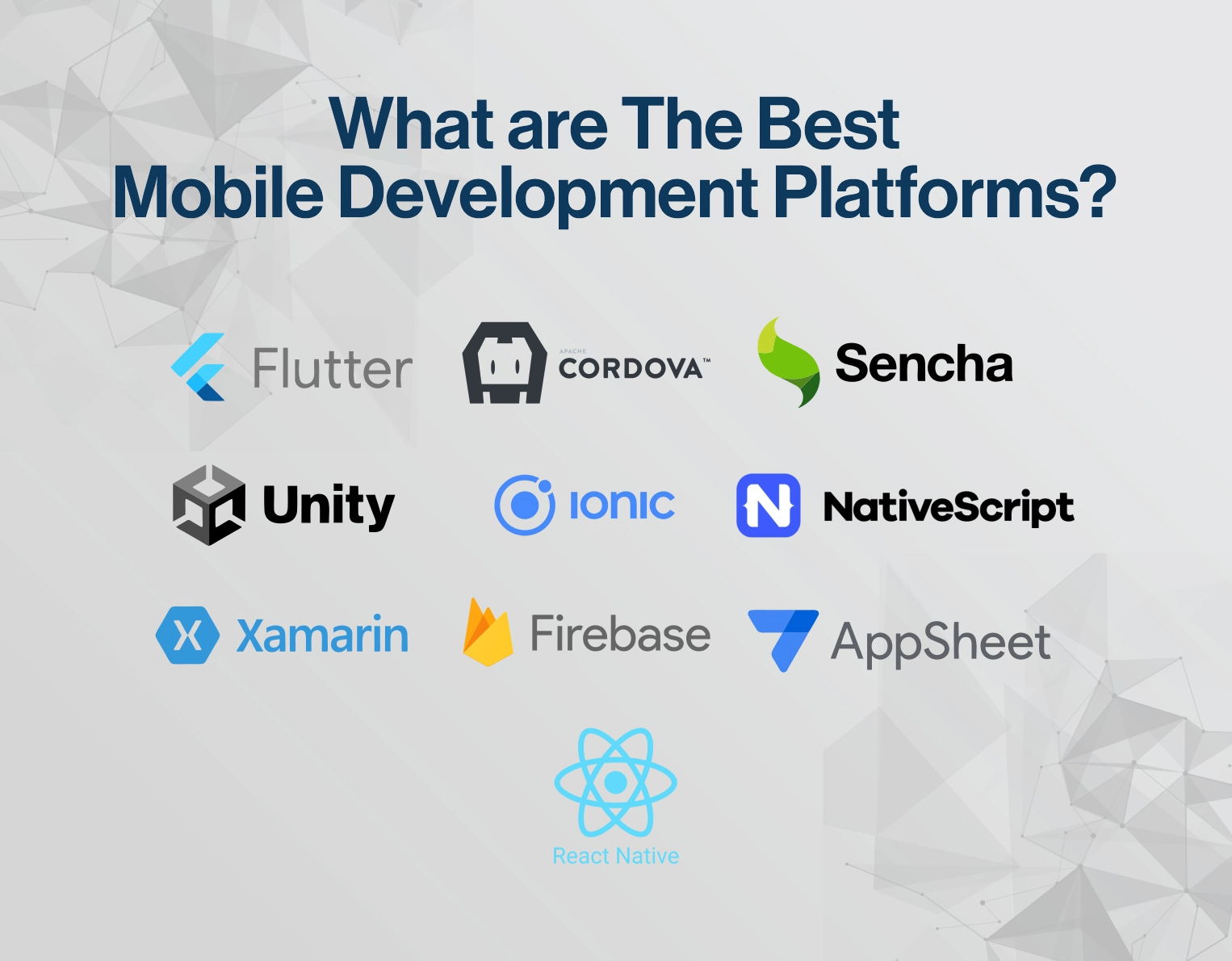Mobile applications today have become indispensable tools for businesses and individuals. From streamlining operations to enhancing user experiences, the demand for innovative mobile apps continues to soar. However, with a myriad of platforms and tools available, navigating the mobile app development landscape can be daunting.
These software tools and frameworks empower developers to build, test, and deploy mobile applications across various platforms, such as iOS and Android, using a single codebase. In this comprehensive guide, we’ll explore some of the top mobile app development platforms, uncovering their benefits, top features, and the best options available for developers.
Whether you’re an experienced developer aiming to enhance your workflow or a business owner aspiring to establish a robust mobile presence, grasping mobile app development platforms is crucial.
https://www.fiveriverstech.com/mobile-app-development/
Key Takeaways:
- Mobile App Development Platforms streamline app creation across iOS and Android with single codebases
- They offer user-friendly environments, reducing development learning curves
- Cross-platform compatibility reduces time and costs by using one codebase for multiple OS
- Cloud integration provides scalability and cost-efficiency without managing infrastructure
- Robust testing and debugging tools ensure app quality and stability
- Key platforms like Flutter offer hot reload, customizable widgets, and multi-platform support
- Cordova leverages web technologies and offers extensive plugin libraries for native features
- Sencha excels in data representation, UI components, and is favored by front-end developers
- Unity provides advanced rendering features and robust analytics for immersive experiences
- Ionic and React Native offer single codebases, rich UI interfaces, and seamless integration with third-party services
- Native Script enables truly native apps with language flexibility and access to native APIs
- Xamarin allows significant code reuse and fully native app development with C# and .NET
- Firebase offers unlimited reporting, audience segmentation, and real-time analytics for data-driven decisions
- App Sheet simplifies app creation from spreadsheets or databases without coding, emphasizing compatibility and ease of use
What are Mobile App Development Platforms?
Mobile App Development Platforms are software tools or frameworks that empower developers to construct, test, and deploy mobile applications across various platforms, such as iOS and Android, utilizing a unified codebase. These platforms streamline the development process by providing a set of tools, libraries, and pre-built components that facilitate the creation of mobile apps.
Benefits of Mobile App Development Platforms
Mobile App Development Platforms offer a range of benefits for developers, businesses, and end-users. Here’s a breakdown of some key advantages:
User-Friendly Development Environment
Mobile app development platforms usually offer intuitive and user-friendly interfaces, simplifying the process for developers to design, develop, and deploy mobile applications even without extensive coding expertise. This accessibility can reduce the learning curve for developers and accelerate the development process.
Cross-Platform Compatibility
Certain platforms frequently endorse cross-platform development, enabling developers to fabricate applications that operate seamlessly across various operating systems like iOS, Android, and occasionally even Windows. This cross-platform compatibility diminishes development time and expenses by facilitating the creation of a single codebase for multiple platforms instead of separate ones for each.
Cloud Integration
Mobile app development platforms often offer built-in integration with cloud services, enabling developers to easily leverage cloud-based resources such as storage, databases, authentication, and analytics. Cloud integration provides scalability, flexibility, and cost-efficiency, as developers can access and utilize cloud resources as needed without having to manage physical infrastructure.
Testing and Debugging Tools
Many platforms are usually furnished with extensive testing and debugging tools that aid developers in guaranteeing the quality and dependability of their applications. These tools frequently incorporate capabilities like automated testing, real-time debugging, performance monitoring, and crash reporting, which streamline the debugging process and enhance the overall stability of the app.
What are The Best Mobile Development Platforms?
1. Flutter
Flutter is a renowned open-source UI software development kit (SDK) created by Google. It is used for building natively compiled applications for mobile, web, and desktop platforms, all from a single codebase.
Features
Single Codebase
Flutter enables developers to write code once and deploy it across various platforms, including iOS, Android, web, and desktop. This significantly reduces the time and effort needed for development compared to creating separate codebases for each platform.
Hot Reload
One of the most favored features of Flutter is its hot reload capability. Developers can modify their code and witness the changes instantly reflected on the emulator or physical device without losing the app’s state. This feature greatly speeds up the development process and enables rapid iteration.
Customizable Widget Sets
Flutter provides a rich set of customizable widgets that enable developers to build highly interactive and visually appealing user interfaces. Widgets in Flutter are composable and customizable, allowing developers to create complex UIs by combining simple widgets. Additionally, Flutter allows for the creation of custom widgets to suit specific design requirements.
2. Cordova
Cordova, also recognized as Apache Cordova, is an open-source mobile development framework enabling developers to create mobile applications using web technologies like HTML, CSS, and JavaScript.
Features
Familiar Technologies
Cordova enables developers to leverage their existing web development skills to build mobile applications. As it utilizes standard web technologies such as HTML, CSS, and JavaScript, developers who are already proficient in these languages can seamlessly transition to mobile app development with Cordova. This lowers the barrier to entry for web developers who want to create mobile applications.
Plugin Library
Cordova provides a vast ecosystem of plugins that extend the functionality of the framework. These plugins allow developers to access native device features and APIs (Application Programming Interfaces) that are not available through standard web technologies. Cordova plugins cover a wide range of functionalities such as camera access, geolocation, file system access, and more. Additionally, developers can create their own custom plugins to integrate with native platform capabilities or third-party services.
These features make Cordova a popular choice for building cross-platform mobile applications, particularly for developers who prefer to use familiar web technologies and want the flexibility to access native device features through plugins. However, it’s worth noting that Cordova apps typically run within a web view container, which may result in performance differences compared to native applications built with platform-specific tools like Flutter, React Native, or Xamarin.
3. Sencha
Sencha is a robust web application development framework offering a plethora of features specifically designed for constructing contemporary, data-intensive web applications.
Features
Visual Data Representation
Sencha offers powerful tools for visualizing data in web applications. It has charting libraries and data visualization components, empowering developers to craft interactive and visually captivating representations of intricate data sets. Whether it’s simple charts, graphs, or more sophisticated data-driven visualizations, Sencha provides the necessary tools to create compelling data representations.
Extensive UI Components
Sencha is renowned for its extensive library of UI components, which are designed to streamline the development of rich and intuitive user interfaces. These components cover a wide range of UI elements, including grids, forms, buttons, toolbars, menus, and much more. Sencha’s UI components are extensively customizable and deliver consistent behavior across various browsers and devices. This simplifies the process for developers to create responsive and refined web applications.
Favorite of Front-end Developers
Sencha has become favored among front-end developers due to its comprehensive array of tools and components, which streamline the development of intricate web applications. It provides a complete development environment equipped with features like code generation, scaffolding, theming, and debugging tools. These elements boost developer productivity and facilitate swift application development. Additionally, Sencha’s extensive documentation and active community support contribute to its appeal among front-end developers.
4. Unity
Unity is a potent and extensively utilized game development platform that provides an array of features designed for game developers as well as creators of interactive applications.
Features
Advanced Rendering Features
Unity provides a highly advanced rendering engine that supports a variety of rendering techniques and features to create visually stunning graphics in games and applications. Some of the advanced rendering features offered by Unity include:
Physically Based Rendering (PBR): Unity’s PBR workflow allows developers to achieve realistic lighting and materials by simulating how light interacts with surfaces in the real world.
High-Definition Render Pipeline (HDRP): HDRP is a rendering pipeline in Unity that provides advanced rendering features such as volumetric lighting, realistic reflections, and improved shader capabilities for creating high-fidelity graphics.
Post-processing Effects: Unity incorporates an extensive selection of post-processing effects like depth of field, motion blur, ambient occlusion, and color grading. These effects can elevate the visual excellence of games and applications.
These advanced rendering features enable developers to create visually stunning and immersive experiences across various platforms.
Analytics
Unity provides powerful analytics tools enabling developers to collect valuable insights into user interactions with their games and applications. Unity Analytics provides features such as:
Player Metrics: Developers can track various player metrics such as session length, retention rates, in-game events, and player progression to understand user behavior and engagement
Performance Monitoring: Unity Analytics offers performance monitoring tools that allow developers to identify performance issues such as frame rate drops, memory usage, and loading times, helping them optimize their games and applications for better performance
Custom Events and User Segmentation: Developers can define custom events and user segments to track specific user actions or behaviors, enabling targeted analysis and optimization strategies
5. Ionic
Ionic is a popular open-source framework for building cross-platform mobile applications using web technologies such as HTML, CSS, and JavaScript/TypeScript.
Features
Single Codebase
Like other cross-platform frameworks like Flutter and React Native, Ionic lets developers maintain a single codebase for building applications that run seamlessly on multiple platforms like iOS, Android, and web. This substantially decreases development time and effort since developers can write code once and deploy it across multiple platforms without the necessity to rewrite or maintain separate codebases for each platform.
UI Interface
Ionic furnishes an extensive array of UI components and pre-designed interface elements, empowering developers to craft intuitive and visually captivating user interfaces for their mobile applications. These UI components include buttons, forms, lists, cards, modals, tabs, and more, which are styled and optimized to provide a consistent look and feel across different platforms.
Additionally, Ionic offers built-in support for popular design frameworks like Material Design and iOS Human Interface Guidelines, allowing developers to create native-like experiences that blend seamlessly with the target platform’s UI standards.
5. React Native
React Native is a popular open-source framework developed by Facebook for building cross-platform mobile applications using JavaScript and React. Some of its top features include:
Features
Integration With Third-party Apps and Platforms
React Native provides robust support for integrating with third-party libraries, APIs, and platforms, allowing developers to leverage existing services and functionalities within their mobile applications.
React Native’s extensive ecosystem includes a wide range of community-maintained packages and modules that provide integration with popular services such as Firebase, GraphQL, AWS, Google Maps, and more. Additionally, React Native offers native modules and bridge APIs that enable developers to access platform-specific features and functionalities not directly supported by React Native.
This flexibility and extensibility make React Native well-suited for integrating with various third-party services, enabling developers to build feature-rich and scalable mobile applications that leverage the power of external APIs and platforms.
Hot Reloading
Hot reloading is one of the key productivity features of React Native, allowing developers to see the changes they make to their code reflected instantly in the running application without the need for a full reload. With hot reloading, developers can iterate quickly on their code, making changes and seeing the results immediately, which significantly speeds up the development process and enhances productivity. Hot reloading preserves the application’s state, allowing developers to maintain their current context and continue testing and refining their application in real-time.
React Native’s hot reloading feature is particularly useful for rapid prototyping, debugging, and UI development, as it eliminates the need for manual rebuilding and reloading of the application after every code change, resulting in a smoother and more efficient development experience.
7. NativeScript
NativeScript is an open-source framework tailored for developing genuinely native mobile applications by leveraging web technologies like JavaScript, TypeScript, and CSS.
Features
Native Apps
With NativeScript, developers can create native mobile applications for iOS and Android platforms. Unlike hybrid frameworks that rely on web views, NativeScript allows developers to build applications that directly access native APIs and render native UI components.
This guarantees that the resultant applications possess the performance, appearance, and sensation of genuinely native apps, delivering users a seamless and immersive experience.
Single Codebase
Similar to other cross-platform frameworks, NativeScript enables developers to maintain a single codebase for building applications that run on multiple platforms. By using a single set of code and UI components, developers can write once and deploy their applications to iOS and Android devices, saving time and effort compared to maintaining separate codebases for each platform.
Language Flexibility
NativeScript offers flexibility in terms of programming languages, allowing developers to choose between JavaScript, TypeScript, and Angular for building their applications. JavaScript is a widely used language with a large developer community, while TypeScript provides additional features such as static typing and advanced tooling for building more robust and maintainable applications. Additionally, NativeScript integrates seamlessly with Angular, a popular web framework, allowing developers to leverage their existing Angular skills and libraries for building mobile applications.
Access to Native APIs
NativeScript provides access to native device APIs and capabilities through a unified JavaScript API layer. This allows developers to access platform-specific features such as camera, geolocation, sensors, and more, directly from their JavaScript or TypeScript code. NativeScript’s plugin ecosystem further extends its capabilities by providing a wide range of plugins that expose additional native functionality and third-party services to developers.
8. Xamarin
Xamarin is a well-known cross-platform mobile development framework, owned by Microsoft, enabling developers to construct native mobile applications using C# and .NET.
Features
Code Reusability
Xamarin enables significant code reuse across different platforms. With Xamarin developers can write a single codebase that targets multiple platforms, including iOS, Android, and Windows, thereby reducing development time and effort. Xamarin provides a set of UI controls and layouts that map to native controls on each platform, allowing developers to create consistent and visually appealing user interfaces with shared code. Additionally, developers can share business logic, data access code, and other non-UI components across platforms, further increasing code reuse and improving maintainability.
Fully Native Apps
Xamarin allows developers to build fully native mobile applications that leverage platform-specific capabilities and performance. Xamarin applications are compiled to native code, resulting in high-performance applications that look, feel, and behave like native apps on each platform. Xamarin provides access to platform-specific APIs and native UI controls through a unified C# API layer, enabling developers to take advantage of platform-specific features such as device sensors, camera, geolocation, and more. Xamarin also allows developers to use platform-specific tools, libraries, and SDKs to integrate with the underlying platform ecosystem seamlessly.
9. Firebase
Firebase is a comprehensive mobile and web application development platform owned by Google, offering a wide range of features and services to help developers build, improve, and grow their applications.
Features
Unlimited Reporting
Firebase provides powerful analytics capabilities through its Firebase Analytics service. With Firebase Analytics, developers can gain insights into how users interact with their applications, including user engagement, retention rates, conversion funnels, user demographics, and more. Firebase Analytics offers unlimited reporting, allowing developers to track and analyze an unlimited amount of data without worrying about data sampling or limitations on the number of events or users tracked.
Firebase Analytics additionally offers real-time reporting, enabling developers to observe user behavior and app performance in real-time. This empowers them to make data-driven decisions and enhance their applications for improved user experiences and business outcomes.
Audience Segmentation
Firebase Analytics allows developers to segment their audience based on various criteria such as user properties, events, user interactions, and more. Developers can create custom audience segments to target specific groups of users based on their behavior, preferences, or characteristics. These audience segments can be used to personalize app experiences, run targeted marketing campaigns, and analyze the behavior of specific user groups.
Additionally, Firebase provides integration with other Firebase services such as Firebase Remote Config, Firebase Cloud Messaging (FCM), and Firebase Predictions, allowing developers to leverage audience segmentation to deliver personalized content, notifications, and experiences to their users.
10. Appsheet
AppSheet is a platform for creating mobile and web applications from spreadsheets or databases without writing code. While it offers a range of features, the specific capabilities you’ve mentioned, access to native APIs and compatibility testing, are not among its primary functionalities.
Features
Access to Native APIs
AppSheet primarily focuses on enabling users to build applications using data from spreadsheets or databases without requiring coding skills. While it provides integration with various data sources such as Google Sheets, Excel, SQL databases, and others, it doesn’t directly offer access to native device APIs. Instead, AppSheet applications typically rely on the platform’s built-in functionality for features such as data synchronization, workflow automation, and user interface customization.
Compatibility Testing
AppSheet applications are automatically generated based on the data and configurations provided by the user. The platform strives to guarantee compatibility across various devices and platforms by producing responsive web apps and native mobile apps for both Android and iOS. However, the platform doesn’t provide explicit compatibility testing features for users to validate the compatibility of their applications across different devices or screen sizes. Instead, AppSheet applications are designed to adapt to various screen sizes and resolutions automatically.
Final Word
Mobile app development platforms offer a streamlined approach to creating robust and user-friendly applications across multiple platforms. From user-friendly interfaces to cross-platform compatibility and cloud integration, these platforms provide developers with the tools they need to bring their ideas to life efficiently.
Whether it’s Flutter’s single codebase approach, Cordova’s familiarity with web technologies, or Xamarin’s fully native app capabilities, there’s a platform suited for every project. Equipped with the appropriate platform, developers can unleash their creativity and craft exceptional mobile experiences that resonate with users globally. The future of mobile app development is bright, thanks to these innovative platforms.
FAQs
1. What is Xamarin Used for?
Xamarin is used for developing cross-platform mobile applications using C# and .NET, allowing developers to write code once and deploy it across multiple platforms like iOS, Android, and Windows.
2. Is Flutter Better Than Xamarin?
Xamarin offers near-native performance. However, it can underperformance in scenarios where complex or heavy computations are involved.
3. Is Flutter Good for AI?
Many developers prefer Flutter for AI as compared to other frameworks.








